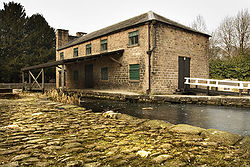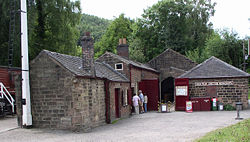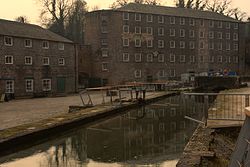Derwent Valley Mills
Derwent Valley Mills is the UNESCO World Heritage Site in Derbyshire, England.[1]
| UNESCO World Heritage Site | |
|---|---|
 Masson Mills, Derwent Valley | |
| Location | Derbyshire, England |
| Criteria | Cultural: ii, iv |
| Reference | 1030 |
| Inscription | 2001 (25th Session) |
| Area | 1,228.7 ha |
| Buffer zone | 4,362.7002 ha |
| Website | www |
| Coordinates | 53°1′44″N 1°29′17″W / 53.02889°N 1.48806°W |
The site covers several factory communities which were built in the 18th and 19th centuries in a valley of the River Derwent, upstream from Derby.[1]
History
Industrial development in the area started with the Silk Mill which was built in Derby in 1721 by John and Thomas Lombe.[1]
In 1771, Richard Arkwright built a water-powered spinning mill at Cromford. In 1776-1777, a larger mill was built nearby. The "factory system "evolved from these two cotton mills. Arkwright's inventions were first put into industrial-scale production.[1]
The workers' housing was near the mills. The mills and houses make up an architectural record of the development of the area.[1]
- Cromford's mills include Masson Mill, Upper Mill (1771) and Lower Mill (1776). There buildings with various original functions: warehouses, workshops, a loom shop, mill managers' houses, etc. The Cromford Canal was built in the 1790s as part of a route to Manchester.[1]
- Belper's mills were Belper North Mill (1804) and East Mill (1912). Its houses are built from gritstone or locally made brick and roofed with Welsh slate.[1]
- Milford's factory buildings have been taken down, but much of the housing survives. Many of the houses are in rows because of the hilly nature of the area. The public buildings established by the Strutts include schools, churches, and public houses.[1]
- Darley Abbey had five water-powered mills - a paper mill, a corn mill, two flint mills (for porcelain production) and a leather mill.[1]
The changes in the valley, including the creation of workers' housing, were important in the Industrial Revolution.
Derwent Valley Mills Media
Model of a water frame at the Historical Museum in Wuppertal
The foundations of the 1775 Cromford Mill which was destroyed by fire in 1890, with wheel chamber on the right.
Cromford Wharf, the terminus of the Cromford Canal
Workshops and offices at High Peak Junction – the southern terminus and the junction with the former Midland Railway now the Derwent Valley Line
Slater Mill in Pawtucket, Rhode Island, incorporated many elements of the factory system developed in the Derwent Valley, and was built by Samuel Slater from Belper.
Cromford Mill was purchased by The Arkwright Society in 1979 after the site was abandoned by its previous owners, a dyes and paints company.
Related pages
References
Other websites
![]() Media related to Derwent Valley Mills at Wikimedia Commons
Media related to Derwent Valley Mills at Wikimedia Commons
- Derwent Valley Miils website Archived 2010-10-04 at the Wayback Machine at DerwentValleyMills.org
- Derwent Valley Mills Archived 2012-04-18 at the Wayback Machine at WorldHeritageSite.org






